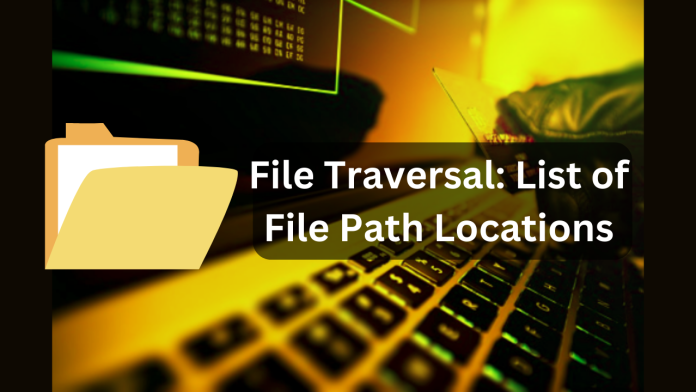When it comes to discovering and exploiting vulnerabilities like File Traversal and Directory Traversal, knowing the precise locations of important files is crucial.
File Traversal and Directory Traversal bugs allow unauthorized access to sensitive information and system files, making them a top priority for security researchers and ethical hackers.
In this article, we will delve into various file locations on a website, providing valuable insights for those hunting for File Traversal and Directory Traversal vulnerability.
Operating System, User Information and Environment Variables
- /root/.bash_profile: Defining Environment Variables
The “/root/.bash_profile” file is often utilized to set various environment variables. Exploiting a File Traversal or Directory Traversal vulnerability to access this file can lead to the exposure of sensitive information or allow manipulation of the environment variables, thereby resulting in potential security breaches. - /etc/os-release and /etc/passwd: Operating System and User Information
The “/etc/os-release” file contains details about the operating system in use, while “/etc/passwd” lists users and symbolic links. Exploiting File Traversal or Directory Traversal bugs to gain access to these files can provide attackers with valuable insights into the system, user accounts, and potential vulnerabilities.
Rich Source of Information
- /proc Directory: Rich Source of Information
The “/proc” directory in Linux systems serves as a treasure trove of information. Files within this directory, such as “/proc/self/environ,” provide crucial details about the application or web environment. Additionally, files like “/proc/cpuinfo” reveal processor/core information, “/proc/meminfo” exposes memory details, “/proc/version” presents the OS type and version, and “/proc/self/comm” identifies the web server used by the website. Knowing the web server version is critical for tailoring specific attacks or identifying potential vulnerabilities.
Log Files: Unveiling Activity and System Details
Log files are often a goldmine of information for attackers. While the specific location of the “access.log” file varies based on the operating system, web server, or system configuration, common locations include:
- /var/log/apache2/* for Apache web server logs
- /var/log/nginx/access.log for Nginx web server logs
- /etc/rsyslog.conf for log configuration
- Additional log files such as /var/log/apport.log, /var/log/auth.log, /var/log/daemon.log, /var/log/dmesg, /var/log/dpkg.log, /var/log/kern.log, /var/log/lpr.log, /var/log/mail., and /var/log/mysql. may also contain valuable information.
User Files: Revealing User Data and Activity
User-specific files can often be accessed through File Traversal or Directory Traversal vulnerabilities. Files like “user.txt” and “.bash_history” in the “/home/{$user}/” directory may contain sensitive data or reveal a user’s activity history. Additionally, the “/home/{$user}/.ssh/id_rsa” file holds SSH keys, which, if obtained, can grant unauthorized access without the need for a password.
Apache HTTP Server Configuration: The Power of httpd.conf
The Apache HTTP server configuration file, “httpd.conf,” is crucial for customizing server behavior. The location of this file varies depending on the distribution:
- /etc/apache2/apache2.conf for Debian/Ubuntu-based systems
- /etc/httpd/httpd.conf or /etc/httpd/conf/httpd.conf for CentOS/RHEL/Fedora
- C:\xampp\apache\conf\httpd.conf for XAMPP (Windows)
Nginx HTTP Server Configuration: Harnessing the Potential of nginx.conf
- The Nginx server configuration file, “nginx.conf,” plays a vital role in securing the server and optimizing its performance. Various locations for this file include:
- /usr/local/nginx/conf/nginx.conf
- /etc/nginx/nginx.conf (commonly used with EasyEngine)
- /usr/local/etc/nginx/nginx.conf
- /etc/nginx/nginx.conf/nginx.conf
- /usr/local/nginx/conf/nginx.conf (Centminmod)
- /etc/nginx/conf.d/nginx.conf (VPSSIM)
- C:\WT-NMP\conf\nginx.conf (WT-NMP for localhost on Windows)
Conclusion
By understanding these key file locations, security researchers and ethical hackers can effectively explore File Traversal and Directory Traversal vulnerabilities and uncover potential system weaknesses. However, it is essential to emphasize that accessing these files without proper authorization is both illegal and unethical. The information provided in this article is solely for educational purposes, aiming to raise awareness about potential security risks.
In conclusion, exploring File Traversal and Directory Traversal vulnerabilities requires knowledge of critical file locations on a website. The mentioned files, including configuration files, log files, and user-specific files, hold valuable information that, if accessed through File Traversal or Directory Traversal bugs, can pose a significant security risk. It is vital for security professionals to remain vigilant, regularly audit their systems, and promptly address any identified vulnerabilities to ensure the safety of their websites and user data.



